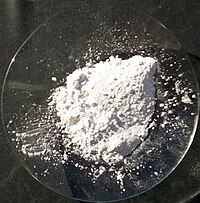Magnesium sulfate
to get this template </nowiki> -->
| Magnesium sulfate | |
|---|---|

| |
| General | |
| Systematic name | Magnesium sulfate heptahydrate |
| Other names | Epsom salts bitter salts |
| Molecular formula | MgSO4·7H2O |
| Molar mass | 120.4 g/mol |
| Appearance | white crystalline solid |
| CAS number | [?] |
| EINECS number | ? |
| Properties | |
| Density and phase | g/cm3, solid |
| Solubility in water | g/100 ml (0 °C) |
| In ethanol | Slightly soluble (anh.) Insoluble (hydrate) |
| Melting point | °C decomp. |
| Structure | |
| Coordination geometry | ? |
| Crystal structure | monoclinic (hydrate) |
| Safety data | |
| PEL-TWA (OSHA) | — |
| RTECS number | ? |
| Supplementary data page | |
| Structure & properties | n, εr, etc. |
| Thermodynamic data | Phase behaviour Solid, liquid, gas |
| Spectral data | UV, IR, NMR, MS |
| Related compounds | |
| Other cations | Calcium sulfate Aluminium sulfate |
| Related compounds | |
| Except where noted otherwise, data are given for materials in their standard state (at 25°C, 100 kPa) Infobox disclaimer and references | |
Magnesium sulfate or Epsom salt is a chemical compound of magnesium with the formula MgSO4. It forms a heptahydrate.
Origin
Epsom salt was originally prepared by boiling down mineral waters at Epsom, England and afterwards prepared from sea water. In more recent times, these salts are obtained from certain minerals such as epsomite.
Agricultural use
In agriculture and gardening, magnesium sulfate is used to correct magnesium deficiency in soil (magnesium is an essential element in the chlorophyll molecule). It is most commonly applied to potted plants, or to magnesium hungry crops, such as potatoes, roses, and tomatoes. The advantage of magnesium sulfate over other magnesium soil amendments (such as dolomitic lime) is its high solubility.
Medical use

Locally it may be used as a treatment of an ingrown nail. Oral magnesium sulfate, or magnesium oxide, is used as a laxative. Epsom salts are also available in a gel form for topical application in treating aches and pains. Intravenous use is broadening, as magnesium sulfate reduces striated muscle contractions and blocks peripheral neuromuscular transmission by reducing acetylcholine release at the myoneural junction, as well as other effects. Indications for its use are:
- Hypomagnesemia (low magnesium concentrations in the blood)
- In cardiac arrhythmias, most notably in:
- Atrial fibrillation
- Torsades de pointes tachycardia
- Treatment (and sometimes prevention) of seizures in eclampsia, for which it is the most effective therapy.
- As a bronchodilator after beta-agonist and anticholinergic agents have been tried, e.g. in severe exacerbations of asthma.[1] In fact, recent studies have revealed that magnesium sulfate can be nebulized to reduce the symptoms of acute asthma (Blitz et al 2005).
- As a tocolytic agent, administered intravenously for the treatment of preterm labor.
- For acute treatment of migraine.
Use in organic chemistry
Anhydrous magnsium sulfate is commonly used as a drying agent in organic synthesis due to its ability to become hydrated. During workup an organic phase is saturated with the compound until it no longer forms clumps. The hydrated solid is then removed with filtration.
A number of other inorganic sulfate salts, sodium sulfate and calcium sulfate for example, may also be used in the same way.
Other uses
Magnesium sulfate is used as a bath salt, particularly in floatation therapy where high concentrations raise the bath water's specific gravity, effectively making the body more buoyant. This property is also used to restore some LavaLamps damaged by being shaken by exchanging the water and adding drops of a concentrated solution until sustainable boyency is reached. Traditionally, it is also used to prepare foot baths, intended to soothe sore feet.
See also
Reference
- ^ Blitz M, Blitz S, Hughes R, Diner B, Beasley R, Knopp J, Rowe BH. Aerosolized magnesium sulfate for acute asthma: a systematic review. Chest 2005;128:337-44. PMID 16002955.
